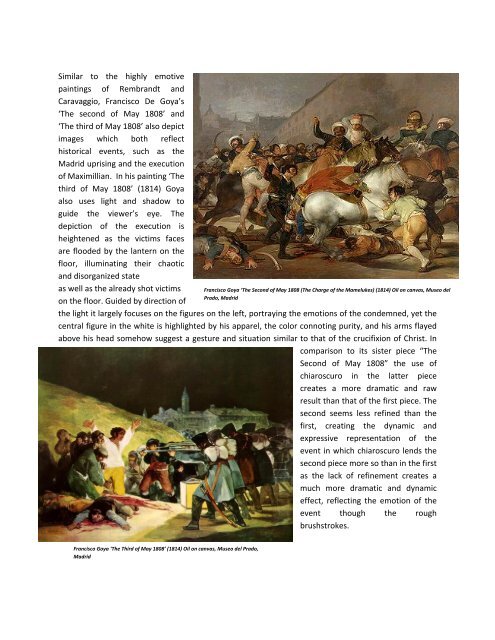A_Level_Personal_Studies_files/Chiaroscuro In Art.pdf
A_Level_Personal_Studies_files/Chiaroscuro In Art.pdf
A_Level_Personal_Studies_files/Chiaroscuro In Art.pdf
You also want an ePaper? Increase the reach of your titles
YUMPU automatically turns print PDFs into web optimized ePapers that Google loves.
Similar to the highly emotive<br />
paintings of Rembrandt and<br />
Caravaggio, Francisco De Goya’s<br />
‘The second of May 1808’ and<br />
‘The third of May 1808’ also depict<br />
images which both reflect<br />
historical events, such as the<br />
Madrid uprising and the execution<br />
of Maximillian. <strong>In</strong> his painting ‘The<br />
third of May 1808’ (1814) Goya<br />
also uses light and shadow to<br />
guide the viewer’s eye. The<br />
depiction of the execution is<br />
heightened as the victims faces<br />
are flooded by the lantern on the<br />
floor, illuminating their chaotic<br />
and disorganized state<br />
as well as the already shot victims<br />
on the floor. Guided by direction of<br />
Francisco Goya ‘The Second of May 1808 (The Charge of the Mamelukes) (1814) Oil on canvas, Museo del<br />
Prado, Madrid<br />
the light it largely focuses on the figures on the left, portraying the emotions of the condemned, yet the<br />
central figure in the white is highlighted by his apparel, the color connoting purity, and his arms flayed<br />
above his head somehow suggest a gesture and situation similar to that of the crucifixion of Christ. <strong>In</strong><br />
comparison to its sister piece “The<br />
Second of May 1808” the use of<br />
chiaroscuro in the latter piece<br />
creates a more dramatic and raw<br />
result than that of the first piece. The<br />
second seems less refined than the<br />
first, creating the dynamic and<br />
expressive representation of the<br />
event in which chiaroscuro lends the<br />
second piece more so than in the first<br />
as the lack of refinement creates a<br />
much more dramatic and dynamic<br />
effect, reflecting the emotion of the<br />
event though the rough<br />
brushstrokes.<br />
Francisco Goya ‘The Third of May 1808’ (1814) Oil on canvas, Museo del Prado,<br />
Madrid



